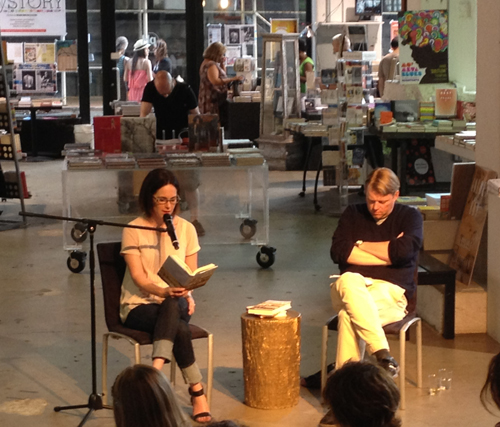
The Exiles required nine years of novelist Allison Lynn, but this week her second novel went on sale and she celebrated at Powerhouse Books, along with her husband, the novelist Michael Dahlie.
The novel follows the lives of Nate and Emily over the course of a three day weekend as they are exiled from New York City to the less expensive Newport, Rhode Island.
After reading a short segment of her book revealing the complicated relationship between Nate and his father that sits at the heart of the narrative, Dahlie begins by asking Lynn questions. He prefaced the discussion by saying that Lynn began writing the novel just as they had met around 2004, and so the book has been constant part of their relationship.
Architecture plays a major role in the book; Nate’s ailing father is a famous and successful architect. Dahlie’s begins by asking why architecture played such a major role in the novel when Lynn had absolutely no background in it.
Architecture melds science and art together, Lynn explains, providing an ideal platform for her characters, both calculating and creative. The book began with Lynn’s own observation of the men around her. At the time she was in her thirties, and the men were constantly aware of the presence of their fathers in their lives. These were men who were otherwise very successful in almost every measure but somehow had never lived up to the expectations of their fathers. Architecture seemed a great way to capture this struggle because a successful architect has left these monuments everywhere across the country. Literally, Nate, cannot get out of the shadow his father. It becomes impossible to escape.
Real estate is a huge deal in New York. Its a constant source of anxiety. Architecture can embody this struggle, especially since these characters, Nate and Emily, are literally being exiled from New York because of the impossibility of the cost of living there. Lynn explains at the time that she was looking for a new apartment in the city, that she would reading apartment listings like other people read crossword puzzles. It served as an important way of structuring these characters to deny them a home.
Nate’s father ultimately is suffering from Huntington’s disease, a debilitating and eventually fatal genetic disease. Dahlie asks why Lynn chose this, of all diseases, especially given that its a well document disease with well documented symptoms, and she, as a writer, had a blank page.
Part of the reason she chose Huntington’s is precisely because the disease is well documented; the specific symptoms helped create the drama. Because its genetic, it generates anxiety for Nate, who doesn’t know whether he has it. It creates anxiety for Emily who spends much of her time worried about many less important things only to realize she should be concerned with whether her child has the disease. Also, since Huntington’s manifests itself later in life, it allowed Nate and Emily to be taken by surprise. And finally, its always fatal.
Huntington’s is a horrific disease; Lynn’s parents, both in the medical field, warned her how terrible it is as she began doing research for the book. She preferred researching the architecture. Architecture was inspiring and after researching it, the words just “poured out of her,” but in her research into Huntington’s, it would shock her, leave her so that she “couldn’t write something for a week.”
The duration of time it took Lynn to write the book seemed like her own bit of anxiety. Dahlie asks her how she knew it was finished given how much time she had spent writing.
Partly of her anxiety, Lynn explains, is that she always convinces herself a book is done before its done, but then her trusted readers point out how its not. One example she cites is with regards to the characterization of Emily. Much of Lynn’s writing is rumination rather than plot; an earlier draft had Emily caught up with too little plot to move the narrative forward and too much rumination. But Lynn didn’t want to cut the rumination of Emily’s character The solution was to dilute the rumination with more plot, which then lead to another six months of writing — and so the process continued.
A member of the audience asked Lynn how much of herself is in Emily — the story does seem to follow a biographical trajectory. Lynn and Dahlie left New York, in part because of the cost, and now have a child, similarly to Nate and Emily. She hadn’t thought it was biographical, and then she found herself living the life of her characters after having written the story.
Emily is a very anxious character constantly worried about the future (by contrast, Nate is concerned with the past). The things she buys or wants do not matter as much as that they serve as signifiers of her security. Nate and Emily’s story is of people “who always thought they’d be in the haves and then find out they’re the almost haves.”
For Lynn, she had always told herself, “I’m totally fine being broke here in New York,” but then found herself looking at apartment listings. Suddenly she was experiencing the same kind of concerns her character was. “The book didn’t seem biographical, and then I lived it,” she said.
Finally, Lynn talks about the authors that she felt inspired by: Doctorow and Ginsberg. She especially liked Ginsberg because he, like her father, was a Jew in Paterson New Jersey. They were “writers who made me see I have stories to tell.”
Lynn has started working on a new novel. She hopes to have it finished within the next twelve years.